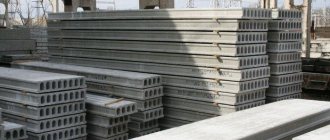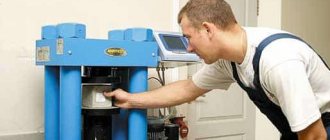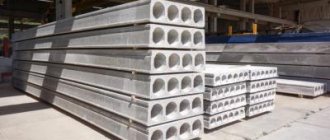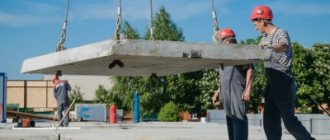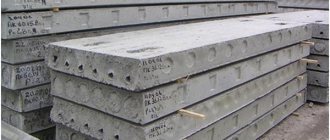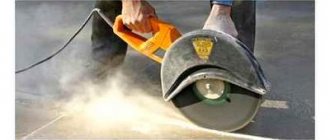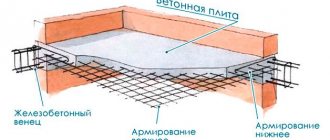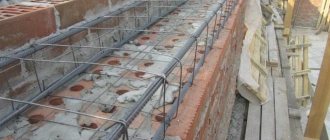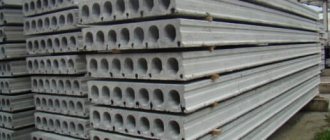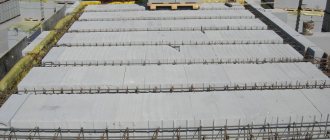Home / Articles / What is the difference between PB boards and PC boards?
One of the most important stages in the construction of a building is the creation of floors. Universal materials used for arranging load-bearing structures in multi-storey residential and non-residential buildings are hollow-core slabs of the PC or PB type.
We will consider the differences between these two flooring options in this article.
Features of manufacturing PC and PB floor slabs
These reinforced concrete products are marked with the PB and PC series and are included in the group of hollow core slab types. The voids are located along the entire length of the product, guaranteeing a reduction in the mass of monolithic materials, as well as significantly increasing heat and sound insulation.
The main difference between these versions of floor slabs is the manufacturing process. PC slabs are produced using the old formwork method. The formless method of continuous formation is the basis for the production of PB floor slabs, sizes and prices
which you will learn further in the text.
Reinforced concrete products of the PC type are made from different grades of concrete (M200-M400). When forming, class AIII reinforcement is used. To increase the strength of products longer than 4.2 m, prestressed reinforcement is used. The creation of slabs is carried out in a special metal formwork with further compaction of the concrete solution using specialized vibration technology.
PB slabs are created using more durable concrete grade M400-M500. During the manufacturing process, products are also reinforced using prestressed reinforcement. This structure of the material will reduce the free deflection of the product and increase resistance to cracking in comparison with the PC analogue.
In order to fully understand the choice of the right floor slabs, it is necessary to study the other advantages and features, geometric and visual parameters of the structures.
Visual parameters of reinforced concrete slabs
For experienced builders, there are no particular difficulties in finding the differences between the two slab options. They only need to inspect the products and draw a conclusion. Special processing of building materials marked PB provides the surface with excellent evenness, neat structure and the absence of visible cracking. This cannot be said about PC analogues, because they have the same shape and therefore have a rough surface. In addition, products can be easily distinguished by the very shape of the cavities.
Geometric indicators of products created using formwork and formless methods:
- Maximum length: PC – 7.2 meters, PB – 10.8 meters.
- The width of the structure varies from 1 to 1.5 meters. There are also PC products with a width of 1.8 meters, however, its impressive weight is a huge disadvantage, due to which such slabs are very rarely used.
- The thickness of concrete products reaches 220 meters.
- The PB board is the heaviest, since similar PC boards are approximately 6% lighter. This is achieved by the very size and shape of the voids of the building material.
- Surface of the material. PB boards have a very smooth surface and fewer defects. All this has a positive effect on the wallet, because it reduces finishing costs and allows you to apply a small layer of screed. PC slabs are created using metal formwork, as mentioned earlier, which negatively affects the surface quality of the finished product.
In general, concrete products marked PB are characterized by high-quality geometry. This is due to the use of continuous molding technology.
Floor slabs. Differences between PB and PC boards
When planning the construction of a house, it is necessary to carefully calculate the cost and feasibility of using all materials. Non-professional builders often have a question about which floor slabs are better to use: PC or PB. In order to make an informed choice, it is necessary to understand the differences between PB and PC boards. As usual, all technical characteristics are laid down at the production stage.
Method of production of floor slabs
PC slabs use reinforced concrete class B15 and higher. Reinforcement is made with prestressed steel reinforcement. Typically, two meshes are used for reinforcement (at the top is BP-I 3-4 mm in diameter, and at the bottom reinforced from 8-12 mm class AIII reinforcement), but if the length of the slab is planned to be more than 4.2 meters, then it is also necessary to prestress the reinforcing elements. AtV reinforcing bars are also used to provide strength for large dimensions. To ensure high-quality fastening of all reinforcing elements, formwork is used in the form of metal forms into which concrete mixture is poured.
For the production of PB slabs, concrete of higher grades is used. For example, our plant uses B30 concrete mix. For reinforcement, we use prestressed wire made from stronger, more expensive metal alloys. It guarantees the products reliability and durability. But at the same time, the weight of the finished product also increases - for example, a PB board is on average 6% heavier than a PC board.
Properties of reinforced concrete products marked PB
Not only visual differences help determine the best floor slabs. There are also technological differences between the two materials, which is an important indicator in the process of construction and repair operations. Due attention should be paid to such indicators as stressed transverse and longitudinal reinforcement. The convenience of using voids for laying utilities and wiring allows you not to violate the integrity of the building material.
Such void differences are very important, because they also affect the overall heat and sound insulation and significantly reduce vibration loads. To ensure greater reliability, additional volumes of concrete are pumped into the PC slabs during the installation process.
Increased reliability is also achieved by the technological molding process itself, the improvement of which makes it possible to create slabs without cracks, which is impossible in outdated formwork technology with surface tension.
Despite many similarities, these two options for floor slabs differ in a number of key indicators that are taken into account when choosing a construction material. The addition of reinforced concrete products with longitudinal reinforcement provides the ability to cut building materials, if necessary, lengthwise, obliquely, crosswise, or at an angle of 45 degrees. In this case, it makes no difference what dimensions of the PB floor slab (GOST
9561-2016). They can be cut as required by the project without harming the overall characteristics of the product.
Such a floor slab is a universal material for performing various non-standard structures during the construction of a building, which is very much appreciated in the construction industry today!
Advantages of building materials
Many professional builders point out that due to innovative methods for manufacturing floor slabs for multi-story buildings with the PB label, they have great potential. For example, the length of the reinforced concrete product itself may be non-standard, which will allow the customer to vary the types of slabs with dimensions of 1.8-9 meters.
An important factor is reducing the weight of PB products to 5-6%, which is impossible without the use of a formless production method. We talked above about the possibility of sawing the material, which allows them to be used to cover bay windows.
Slabs created using the constant formation of concrete mortar without the use of formwork have the following set of technological characteristics:
- High margin of noise insulation.
- Smooth and smooth outer surface of products.
- Withstands impressive mechanical and shock loads.
- Excellent safety margin.
- Use for construction even in the most extreme climatic regions.
- Reduced weight of building materials.
- Increased thermal insulation qualities.
- A wide range of products with different lengths, which is achieved by a special production method.
- Possibility of creating oblique cuts and giving different shapes to concrete products.
- Good resistance to humidity, the impossibility of water penetration into the structure of the concrete slab, and, as a result, the absence of the development of corrosion processes.
You can purchase high-quality PB floor slabs in Kazan. We will offer any sizes and volumes of finished products. Special transport of the enterprise will promptly deliver the cargo to the construction site.
PC and PB: comparative characteristics - “active”
Despite the crisis, the construction business is actively developing in our country. High-quality materials, including hollow-core floor slabs, are in wide demand. The products are excellent for quick construction of structures. There are formwork floor slabs (PC) , made using formwork, as well as extruded floor slabs PB; in their production process, no formwork structure is used.
Technology for the production of formless molded slabs
PB extruder floor slabs are manufactured using the method of continuous formless casting (PB marking means slabs without formwork). The products are passed through a special forming machine, which evenly “presses out” the voids using void formers and extruders.
The length of the slab is 200 meters, so it is cut according to various variations.
For example, the assortment of the AktiVEN building materials store includes models with design widths from 1 m to 20 m. The cuts are made in accordance with established requirements using a laser cutter. The coordination width of the slabs ranges from 270 mm to 1030 mm; the number of holes in the product depends on these indicators.
Continuing the topic of production, it should be noted that the products are reinforced with steel cables. The metal wire used has a small cross-sectional size and is pre-stressed.
As a result, the operational strength of the slab increases. The diameter of the cable is used taking into account the thickness of the floor: the thicker the slab, the larger the diameter of the steel cable used.
The surface of the finished floor slabs, made using the extruder method, is processed with a smoothing apparatus. This helps to level the surface of the products and prevents the formation of surface cracks.
It is no coincidence that extruder boards belong to the new generation of construction products. The products have impressive advantages over classic floor slabs:
• the cost of building a foundation is reduced; • costs are reduced when using special equipment; • As a result, the speed of construction increases.
Technology for the production of formwork floor slabs
The production process of PC boards is based on formwork technology.
The concrete solution is poured into a formwork tray in which metal reinforcement is pre-installed. The reinforced structure is covered and left until final hardening and strength gain.
The list of properties of floor slabs (PCs) used at a construction site should include: • the temperature balance between floors remains unchanged; • floor slabs can be used as load-bearing walls; • products are characterized by water resistance, durability, strength; • the material is fire resistant and can withstand heavy loads; • large range of sizes; • light weight compared to monolithic slabs; • complete isolation of communication channels.
Characteristics of PC floor slabs
Our products labeled PC have the following characteristics:
- The minimum production time for the product is 14 days, which increases the total price of the building material, but reduces the delivery time of the project.
- The versatility of the material. Such reinforced concrete products are often used in all types of structures.
- Additional reinforcement of slabs with stressed reinforcement or simple steel rods.
- High resistance to vibration, increased sound insulation, promoting silence in the constructed premises.
- Resistance to cracking – crack resistance group 3.
- Moisture resistance and reliability of the slab structure.
- Immunity to temperature changes and other weather factors.
- Equipped with mounting lugs allowing for quick transportation of products. There are no such additions in PB slabs.
We offer to evaluate the main distinguishing points of formless slabs and understand the differences between products of a similar type.
Advantages of PB floor slabs
Considering all of the above, we can conclude that PC and PB boards have many common characteristics. However, there are fundamental differences between formless products and formed slabs in frames:
- Higher quality surfaces of finished products. Thanks to the use of modern technical equipment at our plant, which is ready to work around the clock without stopping, our products acquire ideal smoothness, which cannot be said about PC-type slabs.
- For the same reason, PB slabs are distinguished by their ideal geometric dimensions and shape, which facilitates the construction process and installation operations for their installation.
- The use of innovative manufacturing technologies using cable reinforcement ensures the absence of cracks, which is impossible in the manufacture of PC slabs.
- A wide range of finished product sizes, allowing customers to choose slabs from 2 to 12 meters with manufacturing accuracy of up to 0.1 m.
- Ability to withstand enormous loads, varying in size and components of products: 0.6-1.45 t/sq.m.
- Equipping concrete products with prestressed rods for reinforcement, regardless of the dimensions of the reinforced concrete products.
- Creating different angles by cutting without losing the quality of the product.
- Ease of creating holes for communications in PB concrete slabs.
It is important to know! When slinging PB slabs, specialized rigging equipment is used. This provides some inconvenience during transportation. This discomfort is caused by the lack of mounting brackets, as is the case with PC-type analogues.
Types of floor slabs
Before purchasing such products, you should decide which type is required. It is customary to distinguish the following options: PC, PB, PNO, PPS. Let's look at how they differ from each other.
PC slabs mean round hollow-core construction. The thickness is 220 mm. It is made by formwork molding.
PB slabs are multi-hollow products, the thickness is similar to the previous type. Produced using a formless method.
PNO are lightweight models developed using the formwork method.
PPS - bench slabs.
Any of the above structures are manufactured in accordance with GOST.
Each model has its own designations. Having understood them, you can determine which element is needed in a particular case.
As an example, let's take a model from our company's catalog.
PB 22-12-8. Such a slab has a length of 22 dm, a width of 12 dm, the number 8 means the maximum permissible load.
Which is better to choose: PC or PB?
Having analyzed the above information, we can come to the conclusion that building materials marked PC are more correctly used for the construction of residential buildings. It is more convenient to carry out wiring and other communications in them. They provide a reduction in space heating costs, which increases their popularity in the construction market.
And PB floor slabs are ideal for the construction of non-standard buildings. Often these are objects of public use. However, they are also used in the construction of residential buildings, because this largely depends on the developed project. Therefore, it is simply difficult to single out one of the slabs.
If you are planning construction, we recommend contacting our company, whose professionals will quickly select the required type of reinforced concrete floors for your situation. Remember, choosing the wrong building material can lead to serious problems with your home in the future!
